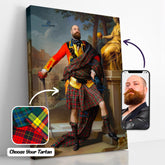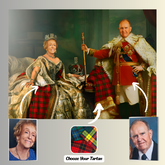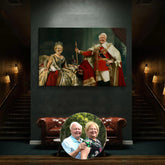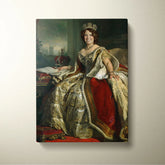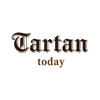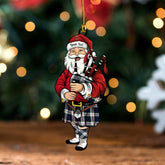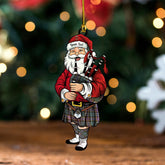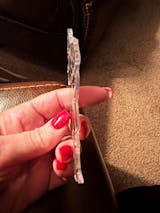-
Personalized Clan Bain Tartan Bagpipe Ornament with Custom Name – Scottish Christmas Tree Decoration XN71
Personalized Clan Bain Tartan Bagpipe Ornament with Custom Name – Scottish Christmas Tree Decoration XN71Celebrate your Scottish heritage with this unique wood & acrylic tartan ornament. Perfect as a personalized Christmas decoration or a meaningful gift for friends and relatives on special occasions such...- From $19.99 USD
$25.99 USD- From $19.99 USD
- Unit price
- per
Save $6.00 -
Clan Bain Tartan Gold Courage Symbol Blanket DH59 - Bain Tartan
Bain Tartan Gold Courage Symbol Blanket DH59 Product Detail: Each blanket features a premium suede polyester print for beautiful color vibrancy. Cozy underside is constructed from an ultra-soft micro fleece fabric to keep you warm and comfortable. Perfect for snuggling while watching TV on...- $65.02 USD
- $65.02 USD
- Unit price
- per
-
Bain Tartan
-
Personalized Clan Bain Tartan Drummer Ornament with Custom Name – Scottish Christmas Tree Decoration WV65
Personalized Clan Bain Tartan Drummer Ornament with Custom Name – Scottish Christmas Tree Decoration WV65Celebrate your Scottish heritage with this unique wood & acrylic tartan ornament. Perfect as a personalized Christmas decoration or a meaningful gift for friends and relatives on special occasions such...- From $19.99 USD
$25.99 USD- From $19.99 USD
- Unit price
- per
Save $6.00 -
Personalized Clan Bain Tartan Bagpipe Ornament with Custom Name – Scottish Christmas Tree Decoration LM26
Personalized Clan Bain Tartan Bagpipe Ornament with Custom Name – Scottish Christmas Tree Decoration LM26Celebrate your Scottish heritage with this unique wood & acrylic tartan ornament. Perfect as a personalized Christmas decoration or a meaningful gift for friends and relatives on special occasions such...- From $19.99 USD
$25.99 USD- From $19.99 USD
- Unit price
- per
Save $6.00 -
Personalized Clan Baird Dress Dance (Baines Dress Dance) Clan Crest Tartan Santa Ornament – Custom Acrylic Christmas Decoration RY76 - Baird
Personalized Clan Baird Dress Dance (Baines Dress Dance) Clan Badge Tartan Ornament – Custom Acrylic Christmas Decoration RY76Celebrate your Scottish heritage with this unique wood & acrylic tartan ornament. Perfect as a personalized Christmas decoration or a meaningful gift for friends and relatives on...- From $19.99 USD
- From $19.99 USD
- Unit price
- per
-
Baird
-
Personalized Clan Baird Dress (Baines Dress) Clan Crest Tartan Santa Ornament – Custom Acrylic Christmas Decoration PI27 - Baird
Personalized Clan Baird Dress (Baines Dress) Clan Badge Tartan Ornament – Custom Acrylic Christmas Decoration PI27Celebrate your Scottish heritage with this unique wood & acrylic tartan ornament. Perfect as a personalized Christmas decoration or a meaningful gift for friends and relatives on special occasions...- From $19.99 USD
- From $19.99 USD
- Unit price
- per
-
Baird
-
Personalized Clan Baird (Baines) Weathered Clan Crest Tartan Santa Ornament – Custom Acrylic Christmas Decoration NU42 - Baird
Personalized Clan Baird (Baines) Weathered Clan Badge Tartan Ornament – Custom Acrylic Christmas Decoration NU42Celebrate your Scottish heritage with this unique wood & acrylic tartan ornament. Perfect as a personalized Christmas decoration or a meaningful gift for friends and relatives on special occasions such...- From $19.99 USD
- From $19.99 USD
- Unit price
- per
-
Baird
-
Personalized Clan Bain Clan Crest Tartan Santa Ornament – Custom Acrylic Christmas Decoration PU40 - Bain
Personalized Clan Bain Clan Badge Tartan Ornament – Custom Acrylic Christmas Decoration PU40Celebrate your Scottish heritage with this unique wood & acrylic tartan ornament. Perfect as a personalized Christmas decoration or a meaningful gift for friends and relatives on special occasions such as Christmas,...- From $19.99 USD
- From $19.99 USD
- Unit price
- per
-
Bain
-
Custom Name Clan Bain Tartan Garden Flag with Clan Crest and the Golden Sword of Courageous Legacy AX52 - Bain
Custom Name Clan Bain Tartan Garden Flag with Clan Crest and the Golden Sword of Courageous Legacy AX52 Immerse your space in the rich heritage of Scotland with our Tartan Garden Flags, exclusively from Tartan Today. Featuring vibrant tartan and Scottish heritage designs, these garden...- From $34.45 USD
- From $34.45 USD
- Unit price
- per
-
Bain
-
Clan Bain Tartan Scotland Map Canvas “Tartan Runs Through My Veins” Wall Art ZE15
Clan Bain Tartan Scotland Map Canvas “Tartan Runs Through My Veins” Wall Art ZE15Celebrate your Scottish heritage with this striking canvas print featuring the map of Scotland filled with Bain tartan, paired with the bold phrase: “Tartan Runs Through My Veins.” Whether you're honoring...- From $35.05 USD
- From $35.05 USD
- Unit price
- per
-
Personalized Clan Bain Tartan Shirt with Scotland Coat of Arms & Custom Name TK53 - Bain
Bain Tartan Shirt with Scotland Coat of Arms & Custom Name TK53Celebrate your Scottish heritage with this Bain Tartan Shirt with Scotland Coat of Arms & Custom Name TK53, featuring a bold Scotland Coat of Arms and your custom name on the back. Made...- From $39.54 USD
- From $39.54 USD
- Unit price
- per
-
Bain
-
Clan Bain Tartan Custom Face Hawaiian Shirt – Unisex Gift for Family Members, Summer Party UA26 - Bain Tartan
Clan Bain Tartan Custom Face Hawaiian Shirt – Unisex Gift for Family Members, Summer Party UA26?? Stand out with our custom face Hawaiian shirt featuring your chosen tartan pattern and up to 10 faces printed for free! Whether it's your own, your pet's, or...- $42.25 USD
$59.99 USD- $42.25 USD
- Unit price
- per
Save $17.74-
Bain Tartan
-
Clan Bain Tartan Flat Cap SX64 - Clan Bain Tartan
Clan Bain Tartan Flat Cap SX64Elevate Your Heritage: The Authentic Tartan Jeff Cap Step into a legacy of timeless style and comfort with our Authentic Tartan Flat Cap. Crafted for the discerning American who cherishes their Scottish roots and appreciates classic elegance, this isn’t just...- From $33.85 USD
$45.59 USD- From $33.85 USD
- Unit price
- per
Save $11.74-
Clan Bain Tartan
-
Clan Bain Tartan Crest, Badges, Heraldry, Clans, Family Scotland PNG, Digital ClipArt High Quality AZ69
Clan Bain Tartan Crest, Badges, Heraldry, Clans, Family Scotland PNG, Digital ClipArt High Quality AZ69 DIGITAL FILE ONLY* ** This listing is an INSTANT DIGITAL DOWNLOAD, not a physical item. An instant download is a digital file you can download and use immediately **...- $3.49 USD
$5.99 USD- $3.49 USD
- Unit price
- per
Save $2.50 -
Clan McBain Chief Tartan Polo Shirt KK94 - McBain Chief Tartan
Clan McBain Chief Tartan Polo Shirt KK94 Description: Crafted in 100% polyester with your own design which combines comfort and vogue. This shirt has some'great features, it has 3 buttons, elastic collar and cuffs. 12.35 Oz. Made from polyester fabric. 3 buttons, elastic collar...- $38.25 USD
- $38.25 USD
- Unit price
- per
-
McBain Chief Tartan
-
Clan Bain Tartan Polo Shirt Viking Wolf SJ56 - Bain Tartan
Clan Bain Tartan Polo Shirt Viking Wolf SJ56 Description: Crafted in 100% polyester with your own design which combines comfort and vogue. This shirt has some'great features, it has 3 buttons, elastic collar and cuffs. 12.35 Oz. Made from polyester fabric. 3 buttons, elastic...- $38.25 USD
- $38.25 USD
- Unit price
- per
-
Bain Tartan
-
Clan Bain Tartan Polo Shirt Half of Me - Cross Style EU47 - Bain Tartan
Clan Bain Tartan Polo Shirt Half of Me - Cross Style EU47 Description: Crafted in 100% polyester with your own design which combines comfort and vogue. This shirt has some'great features, it has 3 buttons, elastic collar and cuffs. 12.35 Oz. Made from polyester...- $38.25 USD
- $38.25 USD
- Unit price
- per
-
Bain Tartan
-
Clan Bain Tartan Polo Shirt - Believe In Me Style UU42 - Bain Tartan
Clan Bain Tartan Polo Shirt - Believe In Me Style UU42 Description: Crafted in 100% polyester with your own design which combines comfort and vogue. This shirt has some'great features, it has 3 buttons, elastic collar and cuffs. 12.35 Oz. Made from polyester fabric....- $38.25 USD
- $38.25 USD
- Unit price
- per
-
Bain Tartan
-
Clan Bain Tartan Polo Shirt EC54 - Bain Tartan
Clan Bain Tartan Polo Shirt EC54 Description: Crafted in 100% polyester with your own design which combines comfort and vogue. This shirt has some'great features, it has 3 buttons, elastic collar and cuffs. 12.35 Oz. Made from polyester fabric. 3 buttons, elastic collar and...- $38.25 USD
- $38.25 USD
- Unit price
- per
-
Bain Tartan
-
Clan Bain Clan Unisex Polo Shirt - Celtic Tree Of Life CC58 - Bain Tartan
Clan Bain Clan Unisex Polo Shirt - Celtic Tree Of Life CC58 Description: Crafted in 100% polyester with your own design which combines comfort and vogue. This shirt has some'great features, it has 3 buttons, elastic collar and cuffs. 12.35 Oz. Made from polyester...- $38.25 USD
- $38.25 USD
- Unit price
- per
-
Bain Tartan
Ex: Your Tartan + Product
Popular Products
Turn Me Royal Personalized Portrait from Your Photo, Custom Tartan. Custom Canvas Wall Art as Gift for Men
- From $32.45 USD
- From $32.45 USD
- Unit price
- / per
Royalty Couple Personalized Portrait from Your Photo, Custom Tartan. Custom Canvas Wall Art
- From $47.45 USD
- From $47.45 USD
- Unit price
- / per
The Queen Personalized Portrait from Your Photo, Custom Tartan. Custom Canvas Wall Art as Gift for Women
- From $32.45 USD
- From $32.45 USD
- Unit price
- / per
Which Clan Are You From?
List Of Tartan
-
Clan A
- Abercrombie Tartan
- Aberdeen Tartan
- Abernethy Tartan
- Adair Tartan
- Adam Tartan
- Ayrshire Tartan
- Agnew Tartan
- Aikenhead Tartan
- Ainslie Tartan
- Aiton Tartan
- Allan Tartan
- Alexander Tartan
- Allardice Tartan
- Allison Tartan
- Anderson Tartan
- Angus Tartan
- Anstruther Tartan
- Arbuthnot Tartan
- Armstrong Tartan
- Arnott Tartan
- Auchinleck Tartan
- Ayrshire Tartan
-
Clan B
- Baillie Tartan
- Bain Tartan
- Baird Tartan
- Balfour Tartan
- Bannatyne Tartan
- Bannerman Tartan
- Barclay Tartan
- Baxter Tartan
- Beaton Tartan
- Bell Tartan
- Belshes Tartan
- Bethune Tartan
- Beveridge Tartan
- Binning Tartan
- Bisset Tartan
- Blackadder Tartan
- Blackstock Tartan
- Black Watch Tartan
- Blair Tartan
- Blane Tartan
- Blyth Tartan
- Borthwick Tartan
- Boswell Tartan
- Bowie Tartan
- Boyd Tartan
- Boyle Tartan
- Brisbane Tartan
- Brodie Tartan
- Brown/ Broun Tartan
- Bruce Tartan
- Buccleuch Tartan
- Buchan Tartan
- Buchanan Tartan
- Burnett Tartan
- Burns Tartan
- Butter Tartan
- Byres Tartan
-
Clan C
- Cairns Tartan
- Calder Tartan
- Callander Tartan
- Cameron Tartan
- Campbell Tartan
- Campbell of Breadalbane Tartan
- Campbell of Cawdor Tartan
- Carmichael Tartan
- Carnegie Tartan
- Carruthers Tartan
- Cathcart Tartan
- Chalmers Tartan
- Charteris Tartan
- Chattan Tartan
- Cheyne Tartan
- Chisholm Tartan
- Christie Tartan
- Clark Tartan
- Clelland Tartan
- Clephan Tartan
- Clergy Tartan
- Cochrane Tartan
- Cockburn Tartan
- Colquhoun Tartan
- Colville Tartan
- Cooper Tartan
- Couper Tartan
- Craig Tartan
- Cranstoun Tartan
- Crawford Tartan
- Crichton Tartan
- Crief District Tartan
- Crosbie Tartan
- Cumming Tartan
- Cunningham Tartan
- Currie Tartan
- Clan D
- Clan E
- Clan F
- Clan G
- Clan H
- Clan I
- Clan J
- Clan K
- Clan L
-
Clan M
- Maitland Tartan
- Malcolm Tartan
- Mar Tartan
- Marjoribanks Tartan
- Maxtone Tartan
- Matheson Tartan
- Maule Tartan
- Maxwell Tartan
- Meldrum Tartan
- Melville Tartan
- Menzies Tartan
- Mercer Tartan
- Middleton Tartan
- Moffat Tartan
- Moncrieffe Tartan
- Montgomery Tartan
- Monypenny Tartan
- Moncreiffe Tartan
- Monteith Tartan
- Morrison Tartan
- Mouat Tartan
- Moubray Tartan
- Mow Tartan
- Muir_More Tartan
- Muirhead Tartan
- Munro Tartan
- Murray Tartan
- Murray of Atholl Tartan
-
Clan Mc/Mac
- MacAlister Tartan
- MacArthur Tartan
- MacAlpine Tartan
- MacAulay Tartan
- MacBain Tartan
- MacBean Tartan
- MacBeth Tartan
- MacCallum Tartan
- MacCraig Tartan
- MacColl Tartan
- MacCorquodale Tartan
- MacDiarmid Tartan
- MacDonald Tartan
- MacDonald of Clanranald Tartan
- MacDonald of Sleat Tartan
- MacDonnell of Glengarry Tartan
- MacDonnell of Keppoch Tartan
- MacDougall Tartan
- MacDowall Tartan
- MacDuff Tartan
- MacEwen_MacEwan Tartan
- MacEdward Tartan
- MacFarlane Tartan
- MacGill Tartan
- MacGillivray Tartan
- MacGregor Tartan
- MacGowan (McGowan) Tartan
- MacHardy Tartan
- MacIan Tartan
- MacInnes Tartan
- MacIntyre Tartan
- MacKay Tartan
- MacKillop Tartan
- MacKellar Tartan
- Mackinlay Tartan
- MacKenzie Tartan
- Mackie Tartan
- MacKinnon Tartan
- MacKintosh / MacIntosh Tartan
- MacLeod Tartan
- MacMillan Tartan
- MacNab Tartan
- MacNaughton Tartan
- MacNeil / MacNeill Tartan
- MacNeil of Colonsay Tartan
- MacNicol Tartan
- MacPhail Tartan
- MacPhee_MacFie Tartan
- MacPherson Tartan
- MacQuarrie Tartan
- MacQueen Tartan
- MacRae Tartan
- MacRow Tartan
- MacSporran Tartan
- MacTaggart Tartan
- MacTavish Tartan
- MacThomas Tartan
- McCorquodale Tartan
- McCulloch Tartan
- McFadzen Tartan
- McGeachie Tartan
- McIver Tartan
- McKerrell Tartan
- Clan N
- Clan O
- Clan P
- Clan R
-
Clan S
- Sandilands Tartan
- Scott Tartan
- Scrymgeour Tartan
- Selkirk Tartan
- Sempill Tartan
- Seton Tartan
- Shaw Tartan
- Shepherd Tartan
- Sinclair Tartan
- Skene Tartan
- Skirving Tartan
- Smith Tartan
- Somerville Tartan
- Spalding Tartan
- Spens Tartan
- Spottiswood Tartan
- Stevenson Tartan
- Stewart Tartan
- Stewart of Appin Tartan
- Stirling Tartan
- Strachan Tartan
- Straiton Tartan
- Strange Tartan
- Strathclyde District Tartan
- Stuart of Bute Tartan
- Sutherland Tartan
- Swinton Tartan
- Clan T
- Clan U W Y
- Request Your Clan
Clan Bain (Bain Tartan)
1. About Clan Bain (Bain Tartan)
2. Clan Bain History (Bain Tartan)
The Clan Bain is unrelated to the MacBain or MacBean families. In actuality, the clan is closely related to Clan MacKay in Scotland's far North West.
Clan MacKay separated into two divisions in 1427 as a result of an internal conflict. The clan's elderly chef Angus Du Mackay and his second son were on one side, and his cousins Morgan Neilson and Niel Neilson MacKay were on the other.
This second group was supported by Clan Sutherland members, which was extremely offensive to the former chief because the Sutherlands had long been the Clan's adversaries.
The final combat between the two factions took place at Drumnacoub, which was close to Kyle of Tongue.
The battle was a failure for the MacKay leadership because in addition to the death of Angus the chief, Morgan and Niel were also killed.
In fact, only a small number of each side's around 3,000 soldiers survived the fierce conflict. Nevertheless, Angus' side prevailed, and his line maintained the chiefship.
Following the conflict, Niel Deilson McKay's son John Bain MacKay changed his last name to John Bain and founded the Bain family.
Moving from Sutherland to Caithness, where John's mother had been relocated for her own protection, he was joined by his family and allies.
The oldest son, John, formed the Bains of Caithness and Haddingtonshire. The second son, William, founded the Bains of Clyth.
John married in 1436 and had four sons. Alexander, the third son, founded the Bains of Tulloch and Dingwall, and Donald, the fourth son, relocated to Galloway.
The name can be spelled in a number of different ways; initially Bane, it was later changed to Bain, and the Tulloch branch also used Bayne. But they all descend from the same parent.
In the Register of All Arms and Bearings in the Court of the Lord Lyon, around 1673, Bain of Tulloch entered the arms.
Before selling the castle and estate to his cousin Henry Davidson in 1762, Kenneth Bayne held the Bayne's seat at Tulloch Castle near Dingwall for more than 200 years.
In Caithness and farther north in Orkney and Shetland, the surname is still widely used.
3. Clan Bain Tartans
The Bain tartan can only be woven as a Special Weave because it is not a stock weave. If you are interested in this, please get in touch with us.
Since Bain belongs to the Clan MacKay, he can don this tartan. The MacGregor tartan is also worn because Bain is a known pseudonym of MacGregor from the Proscription.
Created by Wick-based Trudi Mann for Robert Bain of Lybster, Caithness. It was chosen as the family tartan for all Caithness-based Bains (regardless of spelling).
Details and thread count from March 2004 by Trudi Mann. It has not yet been woven as of August 2004, however Elliots of Selkirk may be working on it. BW changed the name of this from Bains of Cathness in November 2007.
MacKay Modern
MacGregor Modern
4. Clan Bain Crest & Coats of Arms
4.1 Clan Bain Crest
Worn by all of the name and ancestry
4.2 Clan Bain Coat of Arms
Note on Coats of Arms: A coat of arms is given to an individual under Scottish heraldic law (with the exception of civic or corporate arms). A 'family coat of arms' does not exist.
With the exclusions listed above, the weapons depicted below are personal weapons. The only person authorized to use these weapons is the grantee.
Bain Arms
5. Clan Bain Places & People
5.1 Clan Bain Places
Map roughly showing the lands of Clan Bain in the Highlands.
5.2 Clan Bain People
5.2.1 Alexander Bain (11 June 1818 – 18 September 1903)
In the British school of empiricism, Alexander was a Scottish philosopher and educator who made significant contributions to the fields of psychology, linguistics, logic, moral philosophy, and educational reform.
He was a key figure in developing and implementing the scientific method in psychology and founded Mind, the first journal of psychology and analytical philosophy.
At the University of Aberdeen, where he also held professorships in moral philosophy and English literature and was twice elected Lord Rector, Bain was the first Regius Chair in Logic's inaugural class and Professor of Logic.
5.2.2 Thomas Charles John Bain (29 September 1830, Graaff-Reinet – 29 September 1893)
Thomas worked as a road engineer in South Africa. Over the course of a career spanning from 1848 to 1888, Bain, a prolific road building pioneer, was in charge of planning and building more than 900 km of roads and mountain passes, many of which are still in use today.
These routes through the mountain ranges connecting the interior of the old Cape Colony in South Africa with the narrow coastal plain were crucial in allowing access to the country's extensive hinterland.
5.2.3 Alexander Bain (12 October 1810 – 2 January 1877)
Alexander, a Scottish engineer and inventor, was the one who created and patented the electric clock first. He set up the railway telegraph connections connecting Glasgow and Edinburgh.
7. Clan Bain: Uncovering the Rich History and Symbolism of the Bain Tartan
When I was younger, I used to enjoy browsing through gift shops that sold Scottish clan-themed items.
Being proud of my Scottish heritage and having the surname 'Bain,' I would always search for the Bain name, hoping to find items specifically associated with my clan.
However, to my disappointment, I could never find any clan merchandise solely dedicated to the Bain Clan.
I assumed that our surname 'Bain' was associated with the Clan MacBain/McBean, but through extensive research into our genealogy and family history, I discovered that this assumption was incorrect.
In fact, I found that the Clan Bain is actually a sept of the Clan Mackay and has no affiliation with the MacBain/McBean clan.
In my journey of discovery, I also learned about the unique crest and Coat of Arms of the Bain Clan, as well as the absence of a distinct tartan.
This article aims to explore the history, symbolism, and significance of the Bain Tartan, shedding light on the picturesque landscape it represents and guiding those passionate about Scottish heritage to the perfect destination for clan tartans and accessories.
8. Clan Bain and its Relationship with the Clan Mackay
8.1 The Origins of Clan Bain
The Clan Bain traces its origins back to the Scottish Highlands, specifically the Northern Highlands, where the ancestors of the clan settled.
The name 'Bain' itself derives from the Gaelic word "ban," meaning "fair" or "pale." This name came to distinguish the members of the clan, emphasizing their distinctive fair complexions.
8.2 The Acrimonious Split between the Clan Bain and the Clan Mackay
In the 15th century, an acrimonious split occurred between the Clan Bain and the Clan Mackay.
This separation resulted from a dispute over leadership, leading to a complete separation between the two clans.
The Clan Mackay became dominant in the region, while the Clan Bain sought its own path.
9. The Clan Bain Crest and Coat of Arms
9.1 The Clan Bain Crest
Every Scottish clan has its own crest, serving as a symbol of pride and visual representation of its heritage.
The Clan Bain proudly displays its own crest, depicting a sheaf of wheat with a cross above it. This crest represents the agricultural roots of the clan, symbolizing abundance and prosperity.
9.2 The Coat of Arms of the Baynes of Tulloch
Within the Clan Bain, a sect known as the Baynes of Tulloch holds its own Coat of Arms, distinct from the clan's crest.
The Coat of Arms of the Baynes of Tulloch features a griffin rampant, symbolizing courage and nobility, as well as a motto that translates to "Faith and Conquest."
10. The Concept and Significance of Tartans
10.1 The Definition of Tartans
Tartans are woven cloth patterns that represent Scottish clans. Each tartan has its own unique combination of colors and design, reflecting the distinct identity and heritage of a particular clan.
Tartans are often associated with Scottish kilts and are worn by members of the respective clans to display their pride and connection to their ancestral roots.
10.2 The Absence of a Bain Tartan
While the Clan Bain has its own crest and Coat of Arms, interestingly, it does not have its own tartan.
The absence of a specific Bain Tartan can be attributed to the historical split between the Clan Bain and the Clan Mackay, as well as the smaller size and lesser prominence of the Clan Bain as compared to other Scottish clans.
11. The Symbolism and Design of the Bain Tartan
11.1 The Description of the Bain Tartan
Although the Clan Bain does not have its own tartan, members often wear the Bain Tartan, which is predominantly associated with the sept of the Clan MacKay.
The design of the Bain Tartan features a dark blue and forest green background with yellow, white, and red stripes.
Notably, the yellow stripes have a slight curve, while the red and white stripes are thinner than the other colors. The overall design of the tartan is symmetrical, with a repeating pattern of four threads in each color.
11.2 The Symbolism of the Bain Tartan
The colors and design of the Bain Tartan hold symbolic significance, representing the picturesque landscape of the Scottish Highlands.
The dark blue symbolizes the vast sky, while the forest green represents the rolling hills.
The yellow, white, and red stripes symbolize the abundance of flowers and heather found in the Highland terrain. Wearing the Bain Tartan proudly demonstrates a connection to the beauty and natural wonders of Scotland.
12. Scottish Kilt: Celebrating Scottish Heritage with Quality Tartans and Accessories
For those passionate about kilts and Scottish heritage, Scottish Kilt offers the perfect destination to celebrate and embrace their cultural roots. Scottish Kilt is renowned for its focus on quality and craftsmanship, providing custom-made kilts, tartan scarves, and stylish sporrans.
Their collection includes a wide range of high-quality tartans, such as the Bain Tartan, along with various other clan and sept tartans.
Whether it's for a special occasion or simply to showcase your Scottish pride, Scottish Kilt ensures that you can find the perfect tartan and accessories to enhance your connection to your ancestral heritage.
13. Conclusion
Uncovering the history and symbolism of the Bain Tartan has shed light on the unique heritage of the Bain Clan within the broader context of Scottish clans.
Though the Clan Bain does not have its own tartan, the Bain Tartan, associated with the sept of the Clan MacKay, serves as a source of pride for clan members, symbolizing their connection to the Scottish Highlands and the beauty of its landscape.
By exploring the rich history and significance of the Bain Tartan, we can embrace our Scottish heritage and proudly display our cultural roots through the traditional attire of kilts and clan tartans.
Scottish Kilt, with its commitment to quality and exquisite craftsmanship, stands as the ideal destination for those seeking authentic clan tartans and accessories to truly immerse themselves in Scottish tradition.
So, let us wear the Bain Tartan with pride and honor the legacy of the Clan Bain within the tapestry of Scottish history.
- Choosing a selection results in a full page refresh.

